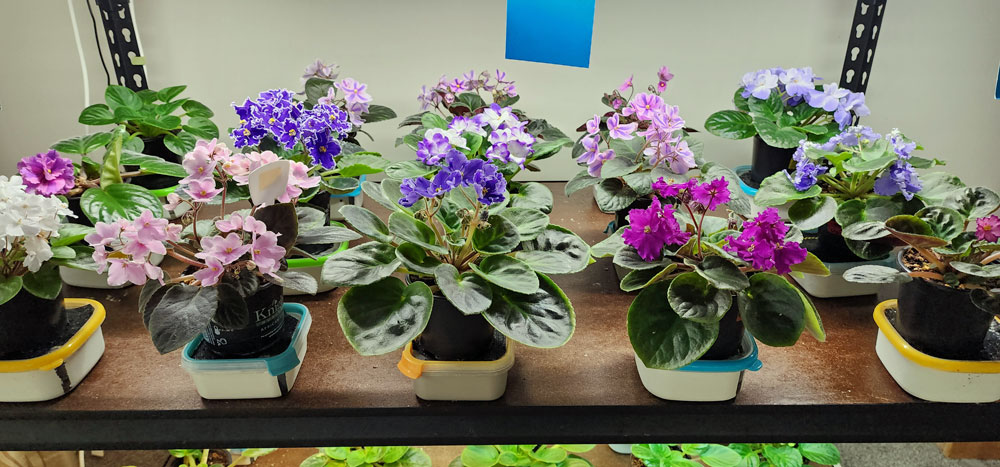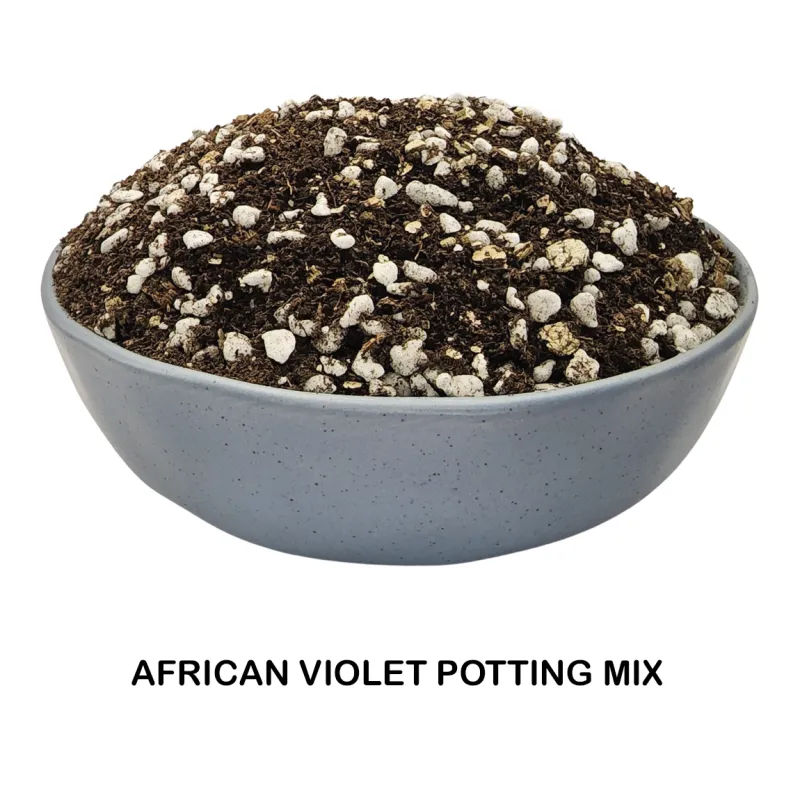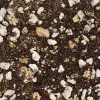Bio Leaf African Violet Potting Mix
Bio Leaf African Violet Potting Mix is specially formulated for African Violets, Streptocarpus, Gloxinias and other members of the Gesneriad family. It is also ideal for plants that prefer a moist potting mix, such as Rex Begonia, Ferns, Syngoniums, Peace Lilies, Baby's Tears and Pitcher plants.
It has a light, fluffy, porous structure, good aeration and drainage. The soil will remain moist without becoming overly soggy.

Properties of Bio Leaf African Violet Potting Mix
Bio Leaf African Violet Potting Mix has been designed not to dry out quickly. After watering, it should remain moist for 5 to 7 days or longer. How long it retains moisture depends on how much water your plant extracts from the potting mix and environmental factors like temperature and humidity.
Ingredients in Bio Leaf African Violet Potting Mix
Bio Leaf African Violet Potting Mix is hand blended from:
- Imported fibrous peat moss.
- Vermiculite.
- Perlite.
- Crushed hardwood charcoal.
- A propriety blend of organic nutrients and growth-enhancing compounds.
Repotting Tips
I like to place about 1 to 2 centimetres of potting mix into the bottom of the pot, which I firm down gently, not too compressed. I believe this improves the absorption and distribution of water. It acts like a sponge/reservoir from which the potting mix will draw water.
Place the plant above this layer and lightly place the potting mix around the plants. Pouring water through the potting mix to settle the mix around the roots. You may need to add extra potting mix after your first watering because the water will cause the potting mix to settle.
Compacting the potting mix with your fingers may snap some of the delicate roots. This may contribute to increasing the effects of transplant shock.
Using a good quality fertiliser like Dyna-Gro GROW 7-9-5 is a good idea and includes a root-stimulating product like Dyna-Gro KLN Rooting Concentrate.
How often should you water African Violets?
African Violets should be kept evenly moist but not waterlogged. There are two techniques you can use to achieve this.
- Select a potting mix that will allow the water to spread throughout the pot. This might not be easy to achieve using a bark-based potting mix. Ideally, the potting mix should contain a generous amount of something like peat, allowing the water to move freely throughout the pot.
- The easiest method is to place the pot on a tray and pour your water into the tray. The potting mix will absorb the mix. If you use a quality potting mix, the water will migrate to the top of the potting mix, and the colour should change to a dark colour. When this happens, remove your African Violet from the tray. Alternatively, let the plant stand for 30 to 60 minutes, allowing enough time for the potting mix to absorb the water.
- Another method is to use a wicking method to water your plants. This involves placing your plant on a container filled with water and using a wick to move the water from the container into the potting mix.
- An easy way to check the moisture levels of your potting mix is to insert a pencil into the pouring mix. If the wood tip of the pencil comes out a darker colour, then your potting mix still contains water, and there is no need to water it.
What fertiliser should I use for my African Violets
The go-to fertiliser in New Zealand for African Violets is Dyna-Gro GROW 7-9-5. Use 1 ml GROW to 1.5 litres of water every time you water. With this dilution rate, you should only feed plants once a week. If you feed your plant twice a week, use 1 ml GROW to 3 litres of water.
Options for additional nutrients
Your plants will grow well using GROW 7-9-5; however, I recommend trying the following combination of nutrients.
To 1.5 litres of water, add the following products:
- 1ml of Dyna-Gro Pro-TeKt.
- 1 ml of Dyna-Gro GROW 7-9-5.
- 0.5 ml of Dyna-Gro Mag-Pro
PS: Always add the Pro-TeKt to your water first. Pro-TeKt will react with your fertiliser and form a gel in a concentrated form. Using a measuring device just for the Pro-TeKt is a good idea or rinse it three times before using it to measure your fertiliser.
Experiment: The above are recommendations, a starting point. Growing conditions differ from person to person, so I encourage you to experiment with different dilution rates to determine what works for your plants.
Why I recommend using the combination of the 3 products.
The combination of GROW & Pro-TeKt provides plants with 17 of the 20 nutrients required for growth and health. Plants get the other 3 (Carbon, Hydrogen and Oxygen) from air and water.
Plants benefit from silicon which helps develop strong cell structures. A few other benefits include helping plants cope with stress, increasing the rate of photosynthesis, helping plants to use some nutrients more efficiently, and rebalancing the pH effect of fertiliser.
Mag-Pro supplies additional Magnesium and Sulphur. Magnesium improves the leaf colour (Photosynthesis), and Sulphur increases flower count, colour and size.
What about using a seaweed concentrate?
For general maintenance and conditioning, seaweed can be applied once a month. Seaweed can be applied as a foliar spray or as a pot drench.
Adding seaweed to the solution used for wick watering may cause your nutrient solution to putrify and introduce unwanted organisms into your water and potting mix.
Seaweed is a tonic that improves and boosts plant vigour, helps plants cope with stress and defend against insect attacks, and has many other benefits.
Using seaweed is also an attempt to supply nutrients and organic compounds missing from our fertilisers.
The over-application of seaweed may stimulate plant growth to the point that a plant will produce deformed leaves or flowers. Fortunately, the damage is not permanent; all you need to do is stop using seaweed until the plant produces leaves and flowers that are not deformed.
Acknowledgement.
I want to thank Bruce Andrew for the advice provided in developing this potting mix. Bruce is one of the top New Zealand African Violet growers and has been growing them for more than 40 years. He has also been growing streptocarpus, other gesneriads and begonias for 10 years and has a wealth of knowledge and experience with growing these plants.
Bruce is an active member of many plant groups and freely gives advice and shares his knowledge.








